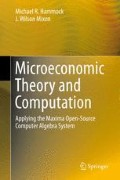Abstract
Building on the production theory developed and illustrated in Chap. 6, this chapter analyzes and illustrates the relationship between the quantity produced and production cost. The illustration is based on the production function and the assumption that each of the two inputs can be purchased in competitive resource markets. Also, the firm is assumed to employ resources in a cost-minimizing combination.
Access this chapter
Tax calculation will be finalised at checkout
Purchases are for personal use only
Notes
- 1.
The first derivative of the total cost function, the marginal cost, is positive throughout the relevant output range. At first the second derivative of the total cost function is negative. At higher output rates the second derivative becomes positive. At the point of inflection, the second derivative equals zero.
- 2.
In the short run, \(dx = \frac{dx} {dL} \cdot dL = mpl \cdot dL\) and d(stc) = w ⋅ dL, so \(smc = \frac{d(stc)} {dx} = \frac{w} {mpl}\).
- 3.
The formal analysis does not distinguish between fixed costs and sunk costs. They are not quite the same. Some fixed costs (i.e., costs that are the same for all positive output rates) might be avoided if the firm shuts down and sells off or sub-leases some of its capital. Those capital costs that cannot be avoided in this way are sunk costs, and they are part of the fixed cost.
Author information
Authors and Affiliations
Rights and permissions
Copyright information
© 2013 Springer Science+Business Media, LLC
About this chapter
Cite this chapter
Hammock, M.R., Mixon, J.W. (2013). Cost Theory. In: Microeconomic Theory and Computation. Springer, New York, NY. https://doi.org/10.1007/978-1-4614-9417-1_7
Download citation
DOI: https://doi.org/10.1007/978-1-4614-9417-1_7
Published:
Publisher Name: Springer, New York, NY
Print ISBN: 978-1-4614-9416-4
Online ISBN: 978-1-4614-9417-1
eBook Packages: Business and EconomicsEconomics and Finance (R0)

